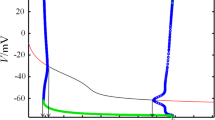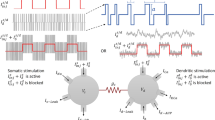Abstract
Spike-frequency adaptation has been shown to play an important role in neural coding. Based on a reduced two-compartment model, here we investigate how two common adaptation currents, i.e., voltage-sensitive potassium current (\(I_{\mathrm{M}}\)) and calcium-sensitive potassium current (\(I_{\mathrm{AHP}}\)), modulate neuronal responses to extracellular electric fields. It is shown that two adaptation mechanisms lead to distinct effects on the dynamical behavior of the neuron to electric fields. These effects depend on a neuronal morphological parameter that characterizes the ratio of soma area to total membrane area and internal coupling conductance. In the case of \(I_{\mathrm{AHP}}\) current, changing the morphological parameter switches spike initiation dynamics between saddle-node on invariant cycle bifurcation and supercritical Hopf bifurcation, whereas it only switches between subcritical and supercritical Hopf bifurcations for \(I_{\mathrm{M}}\) current. Unlike the morphological parameter, internal coupling conductance is unable to alter the bifurcation scenario for both adaptation currents. We also find that the electric field threshold for triggering neuronal steady-state firing is determined by two parameters, especially by the morphological parameter. Furthermore, the neuron with \(I_{\mathrm{AHP}}\) current generates mixed-mode oscillations through the canard phenomenon for some small values of the morphological parameter. All these results suggest that morphological properties play a critical role in field-induced effects on neuronal dynamics, which could qualitatively alter the outcome of adaptation by modulating internal current between soma and dendrite. The findings are readily testable in experiments, which could help to reveal the mechanisms underlying how the neuron responds to electric field stimulus.














Similar content being viewed by others
References
Benda J, Herz AV (2003) A universal model for spike-frequency adaptation. Neural Comput 15(11):2523–2564
Benda J, Longtin A, Maler L (2005) Spike-frequency adaptation separates transient communication signals from background oscillations. J Neurosci 25(9):2312–2321
Benda J, Maler L, Longtin A (2010) Linear versus nonlinear signal transmission in neuron models with adaptation currents or dynamic thresholds. J Neurophysiol 104(5):2806–2820
Bikson M, Inoue M, Akiyama H, Deans JK, Fox JE, Miyakawa H, Jefferys GR (2004) Effects of uniform extracellular DC electric fields on excitability in rat hippocampal slices in vitro. J Physiol 557(Pt 1):175–90
Brøns M, Krupa M, Wechselberger M (2006) Mixed mode oscillations due to the generalized canard phenomenon. Fields Inst Commun 49:39–63
Brown DA, Adams PR (1980) Muscarinic suppression of a novel voltage-sensitive K\(^{+}\) current in a vertebrate neurone. Nature 283(5748):673–676
Carnevale NT, Hines M (2005) The NEURON Book. Cambridge University Press, Cambridge
Chan CY, Hounsgaard J, Nicholson C (1988) Effects of electric fields on transmembrane potential and excitability of turtle cerebellar Purkinje cells in vitro. J Physiol 402:751–71
Chan CY, Nicholson C (1986) Modulation by applied electric fields of Purkinje and stellate cell activity in the isolated turtle cerebellum. J Physiol 371:89–114
Desroches M, Guckenheimer J, Krauskop B, Kuehn C, Osinga HM, Wechselberger M (2012) Mixed-mode oscillations with multiple time scales. SIAM Rev 54(2):211–288
Drion G, Franci A, Seutin V, Sepulchre R (2012) A novel phase portrait for neuronal excitability. PLoS One 7(8):e41806
Durand DM (2003) Electric field effects in hyperexcitable neural tissue: a review. Radiat Prot Dosimetry 106(4):325–31
Ermentrout B (1998) Linearization of F-I curves by adaptation. Neural Comput 10(7):1721–1729
Ermentrout B (2002) Simulating, analyzing, and animating dynamical systems: a guide to XPPAUT for researchers and students. SIAM, Philadelphia
Goodman D, Brette R (2008) Brian: a simulator for spiking neural networks in python. Front Neuroinform 2:5
Hu H, Vervaeke K, Storm JF (2002) Two forms of electrical resonance at theta frequencies, generated by M-current, h-current and persistent Na\(^{+}\) current in rat hippocampal pyramidal cells. J Physiol 545(Pt 3):783–805
Izhikevich EM (2005) Dynamical systems in neuroscience: the geometry of excitability and bursting. The MIT Press, London
Kimiskidis VK, Kugiumtzis D, Papagiannopoulos S, Vlaikidis N (2013) Transcranial magnetic stimulation (TMS) modulates epileptiform discharges in patients with frontal lobe epilepsy: a preliminary EEG-TMS study. Int J Neural Syste 23(1):1250035
Liu YH, Wang XJ (2001) Spike-frequency adaptation of a generalized leaky integrate-and-fire model neuron. J Comput Neurosci 10(1):25–45
Madison DV, Nicoll RA (1984) Control of the repetitive discharge of rat CA1 pyramidal neurones in vitro. J Physiol 354:319–31
Marino F, Marin F, Balle S, Piro O (2007) Chaotically spiking canards in an excitable system with 2D inertial fast manifolds. Phys Rev Lett 98(7):074104
Mclntyre CC, Grill WM (1999) Excitation of central nervous system neurons by nonuniform electric fields. Biophys J 76(2):878–88
Milik A, Szmolyan P, Loeffelmann H, Groeller E (1998) Geometry of mixed-mode oscillations in the 3-D autocatalator. Int J Bifurc Chaos 8(3):505–519
Moehlis J (2006) Canards for a reduction of the Hodgkin–Huxley equation. J Math Biol 52:141–153
Nagarajan SS, Durand DM, Warman EN (1993) Effects of induced electric fields on finite neuronal structures: a simulation study. IEEE Trans Biomed Eng 40(11):1175–88
Park EH, Barreto E, Gluckman BJ, Schiff SJ, So P (2005) A model of the effects of applied electric fields on neuronal synchronization. J Comput Neurosci 19(1):53–70
Park EH, So P, Barreto E, Gluckman BJ, Schiff SJ (2003) Electric field modulation of synchronization in neuronal networks. Neurocomputing 52–54:169–175
Pashut T, Wolfus S, Friedman A, Lavidor M, Bar-Gad I, Yeshurun Y, Korngreen A (2011) Mechanisms of magnetic stimulation of central nervous system neurons. PLoS Comput Biol 7(3):e1002022
Peron S, Gabbiani F (2009) Spike frequency adaptation mediates looming stimulus selectivity in a collision-detecting neuron. Nat Neurosci 12(3):318–326
Peterchev AV, Wagner TA, Miranda PC, Nitsche MA, Paulus W, Lisanby SH, Pascual-Leone A, Bikson M (2012) Fundamentals of transcranial electric and magnetic stimulation dose: definition, selection, and reporting practices. Brain Stimul 5(4):435–453
Pineda JC, Galarraga E, Foehring RC (1999) Different Ca\(^{2+}\) source for slow AHP in completely adapting and repetitive firing pyramidal neurons. Neuroreport 10(9):1951–1956
Prescott SA, De Koninck Y, Sejnowski TJ (2008a) Biophysical basis for three distinct dynamical mechanisms of action potential initiation. PLoS Comput Biol 4(10):e1000198
Prescott SA, Ratté S, De Koninck Y, Sejnowski TJ (2006) Nonlinear interaction between shunting and adaptation controls a switch between integration and coincidence detection in pyramidal neurons. J Neurosci 26(36):9084–9097
Prescott SA, Ratté S, De Koninck Y, Sejnowski TJ (2008b) Pyramidal neurons switch from integrators in vitro to resonators under in vivo-like conditions. J Neurophysiol 100(6):3030–3042
Prescott SA, Sejnowski TJ (2008) Spike-rate coding and spike-time coding are affected oppositely by different adaptation mechanisms. J Neurosci 28(50):13649–13661
Radman T, Ramos RL, Brumberg JC, Bikson M (2009) Role of cortical cell type and morphology in sub- and suprathreshold uniform electric field stimulation. Brain Stimul 2(4):215–228
Rubin J, Wechselberger M (2007) Giant squid-hidden canard: the 3D geometry of the Hodgkin–Huxley model. Biol Cybern 97(1):5–32
Sharpee TO, Sugihara H, Kurgansky AV, Rebrik SP, Stryker MP, Miller KD (2006) Adaptive filtering enhances information transmission in visual cortex. Nature 439:936–942
Svirskis G, Baginskas A, Hounsgaard J, Gutman A (1997) Electrotonic measurements by electric field-induced polarization in neurons: theory and experimental estimation. Biophys J 73(6):3004–15
Tranchina D, Nicholson C (1986) A model for the polarization of neurons by extrinsically applied electric fields. Biophys J 50(6):1139–56
Wagner T, Valero-Cabre A, Pascual-Leone A (2007) Noninvasive human brain stimulation. Annu Rev Biomed Eng 9:527–565
Walsh V, Cowey A (2000) Transcranial magnetic stimulation and cognitive neuroscience. Nat Rev Neurosci 1(1):73–79
Wang XJ (1998) Calcium coding and adaptive temporal computation in cortical pyramidal neurons. J Neurophysiol 79(3): 1549–1566
Wark B, Lundstrom BN, Fairhall A (2007) Sensory adaptation. Curr Opin Neurobiol 17(4):423–429
Xie Y, Chen L, Kang YM, Aihara K (2008) Controlling the onset of Hopf bifurcation in the Hodgkin–Huxley model. Phys Rev E 77(6 Pt 1):061921
Yi GS, Wang J, Deng B, Wei XL (2015) Spike initiating dynamics of the neuron with different adaptation mechanisms to extracellular electric fields. Commun Nonlinear Sci Numer Simul 22(1–3):574–586
Yi GS, Wang J, Wei XL, Tsang KM, Chan WL, Deng B (2014a) Neuronal spike initiation modulated by extracellular electric fields. PLoS ONE 9(5):e97481
Yi GS, Wang J, Wei XL, Tsang KM, Chan WL, Deng B, Han CX (2014b) Exploring how extracellular electric field modulates neuron activity through dynamical analysis of a two-compartment neuron model. J Comput Neurosci 36(3):383–399
Acknowledgments
This work is supported by the National Natural Science Foundation of China under Grants 61471265, 61372010 and 61172009, and Tianjin Municipal Natural Science Foundation under Grants 12JCZDJC21100 and 13JCZDJC27900.
Author information
Authors and Affiliations
Corresponding author
Rights and permissions
About this article
Cite this article
Yi, G., Wang, J., Tsang, KM. et al. Spike-frequency adaptation of a two-compartment neuron modulated by extracellular electric fields. Biol Cybern 109, 287–306 (2015). https://doi.org/10.1007/s00422-014-0642-2
Received:
Accepted:
Published:
Issue Date:
DOI: https://doi.org/10.1007/s00422-014-0642-2




